Note: all links will open in a new tab so you won’t lose this page.
Electricity & Power
While the news covers solar, wind, and other renewables these days much more than it used to, our world is still predominantly powered by fossil fuels, as demonstrated by the following graphic from the Lawrence Livermore National Lab. The thickness of lines indicates the volume of each power source. Note that solar (in yellow), geothermal (brown) and wind (in purple), which are the best renewable energy (“clean tech”) options, are represented by much smaller lines than coal, natural gas, and petroleum.

Of course, this is changing. The world continues to turn its focus to cleaner sources of energy, but even in the best case scenarios, we are going to burn a lot of fossil fuels before we get to a 100% clean energy future.
Burning fossil fuels and greenhouse gas emissions: the basics
One of the guiding principles of physics is that mass is neither created nor destroyed…it only changes form. So when fuel is burned (a log on a campfire, for instance), the fuel turns from solid (wood) to gas (smoke). For our purposes here, just think of mass as how much something weighs, though technically it’s more complicated than that. The amount of material is unchanged: a 5 pound log will (in general) produce 5 pounds of smoke. This is how greenhouse gases are created from fossil fuels. Carbon dioxide is the best known greenhouse gas (GHG), so typically GHG emissions are measured against a benchmark of pounds of CO2 equivalents. Methane, produced in large quantities in animal agriculture, is 21-24 times more destructive as a GHG, so one pound of methane emissions would be, for instance, 21-24 pounds of CO2 equivalents.
Many fossil fuels operate similarly to create electricity. When you burn coal, for instance, it creates heat (20 million BTUs, a measure of heat, are generated by a ton of coal, according to the Energy Information Administration). That heated gas runs through machinery and infrastructure, where it makes turbines spin in a power plant, which generate electricity. Natural gas, oil fuels, and many other fuels operate similarly. This is an oversimplification, but is sufficient for our purposes here.
Further readings:
How Energy is Produced and Transmitted and the Difference Between Clean and Dirty Power
Electricity distribution: the basics
Much of our energy infrastructure (the ‘grid’) was set up as a hub and spoke model. One large centralized power plant would produce electricity, then send that electricity via powerlines to the end user (homes, businesses, industry). Along the way, some 5-7% of that energy will never reach its final destination. This is referred to as “grid loss“, and is more or less a function of the inefficient transfer of energy. The farther this power has to travel to get to the end user, in general, the more energy can be lost. This is one of the main reasons why changing the hub and spoke model for a distributed energy system is desirable. An example of distributed systems would be a house that has solar panels and a battery storage system. That is, effectively, a one house micro-grid. The power has fewer transistors and less wiring to travel through, and therefore hypothetically is a more fluid, efficient system.
Further readings:
Electricity use: renewables, demand response, and timing
Demand for electricity peaks usually from 6-9 PM. This is because people come home from work, switch on the TV, start cooking, playing video games, doing laundry, etc. During the day, energy use goes down quite a bit, since most people are at work or school. Similarly, at night, with most people in bed, electricity demand is low.
The time of use of electricity has major implications. Solar and wind are “intermittent” energy sources. This is in contrast to “baseload” sources, which can run all day every day. Baseload sources include fossil fuels, as well as some renewables such as biomass, geothermal, and wave energy. So how do we allow excess solar energy created during the day to be used in peak demand hours? That is the science known as demand response, and it’s a critical lynchpin to our clean energy future. Part of the answer is in energy storage. A battery that can hold energy created by the sun and then later disperse it after the sun goes down (or when it’s windy and later disperse when it’s not windy) is helpful to eliminate fossil fuel consumption.
There are other reasons people might want a home battery system. First, if the power goes out, the battery can keep a person from losing all their refrigerated food. In fact, many people with house batteries don’t even realize when the power goes out! Second, their utility might charge a different rate during peak demand times. This is called Time of Use pricing. It’s a market mechanism often mandated by a Public Utility Commission to help incentivize people to shift their use to times when there’s more abundant and less expensive electricity in the supply. For instance, Xcel Energy has one such program where a higher rate is charged during peak demand times (16-21 cents per kWh), and then another rate (4 cents) for off-peak times. So if you have a battery, you can power it up when it costs 4 cents a kilowatt hour, then discharge into your home when electricity costs 4-5x more. This does not hurt the utility – in fact it makes their lives easier by reducing their need to fire up backup generators to cover peak demand. It’s often referred to as “Peak shaving”. If the homeowner has solar, they can harvest all the extra electricity their solar system makes during the day and that might otherwise have been sold back to the grid for pennies, and use it for their home during the night. In the article below, you’ll see a good example of this.
Further reading:
Time of use, home batteries, and electric vehicles
Terminology
Technically, electric energy starts as potential energy, measured in volts. When switched on, an electric circuit generates power. We measure power by combining how much electric energy is transferred and how fast the transfer happens (in joules per second, or watts). Most circuits transform the electric energy into mechanical or some other form of energy.
A watt (or kilowatt, megawatt, gigawatt, or terawatt) expresses how much electricity can be generated at a specific moment by a power plant, or how much is needed to power something (like a light bulb). We rate power plants in watts (or, more likely, kilowatts, megawatts, or gigawatts) to indicate the maximum amount of power a plant can put out at a given point in time. The largest solar PV power plant in the world has a rating of 2 gigawatts, and the smallest US nuclear plant has a capacity of 502 MW. The largest single nuclear plants are three times that size, while nuclear stations go up to about 8,000 MW, or 8 GW (7 reactors). Three Gorges Dam (hydroelectric) in China is currently the largest electric power plant in the world, with a 22,500 MW (22.5 GW) electricity generation capacity.
Watt-hours indicate how much electricity is produced over time. What you see on your electric bill indicating electricity usage for the month is in kilowatt-hours (1000 watt-hours).
A few related definitions are helpful. Amps = Amount of electricity flowing, Volts = Strength of electricity flowing, Watts is Amps times Volts to show total working capacity of that electricity. Some appliances only list amps and volts, so understanding this equation can help you determine how much wattage an appliance will use. The most common line voltage in the USA is 120 volts (V). Some exceptions are dryers that require more voltage. These use 220 V and have a larger plug and outlet.
Further readings:
Understanding wattage, amperage, and voltage
Electricity & Power Key Takeaways
- The difference between energy and electricity is fundamental to understanding conversion efficiency.
- Energy is lost as it hits resistance, and a good share of energy produced at central power plants never reach their final destination (e.g., residences and other buildings) due to being transmitted through a power line.
Utilities in the Home
Energy: Kilowatts in practice
Once the electricity gets to the end user (e.g., your home), it is used to power your fridge, your AC, the lights, the TV, etc. The more energy your home uses, the more you spend on your electric bill. Typically, your power utility will bill you for this electricity with a flat rate on how many kilowatt-hours (1,000 watts for 1 hour = 1 kilowatt-hour), or kWh in shorthand. There are some utilities that use “time of use” pricing, meaning that during peak demand times they charge more (typically peak demand occurs as people are getting home from work, and in the summer, during the heat of the day as ACs kick on across the grid). And sometimes, there are tiered structures, meaning that you pay x per kilowatt hour for the first 100 or so kWh, then x+y for the next 100 kWh, then x+y+z for the next 100, and so on. This tiered structure helps discourage consumption from those who use the most power.
To calculate kilowatt hours something is using, you simply crunch some numbers. Let’s say a 100 watt lightbulb is on for 1 hour. This is 100 watts x 1 hour, or 100 watt-hours. There are 1000 watts in a kilowatt, so you divide by 1,000, and you get 0.1 kWh. You can expand this to a monthly electric bill simply by multiplying the wattage of a device by the number of days in the month, and the average number of hours per day the device is on. For the 100 watt bulb, if it’s on 1 hour per day, it’s 100 watts x 1 hour per day x 30 days per month, yielding 3,000 watt hours, or 3 kWh. If you have 10 of these lights on in your house, you’re looking at 30 kWh. If they’re on for more than one hour, you can simply adjust the equation to get your monthly kWh budget. And so on.
That’s one lightbulb. Appliances take this to another level.Check out these graphics (courtesy of Hawaiian Electric), showing the difference in energy use between washing and rinsing laundry in hot vs. cold water, and on how much energy is used if your dryer vent is clogged.
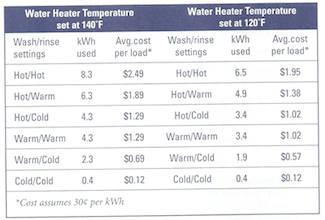

In the article below, there’s a graphic from Hawaiian Electric on the breakdown of energy use by appliance in the average home. Note that heating doesn’t exist in Hawaii for all intents and purposes, but its energy consumption in cold climates would rival that of the AC in this graphic.
Suggested readings:
Energy use by appliance: which uses the most?
Water in the Home
In a recent survey, home efficiency company Pono Home polled 550 recent customers about what they’d learned from their service (roughly 22% responded). The questions ranged from how watt ratings on lightbulbs translate into dollars on electric bills, how to set up an advanced power strip, insights on vampire power, and more. The number one response (the single thing that people didn’t quite understand before but did after the service) was how water use affects their electric bill. This answer also received the highest number of responses as “the most important thing” people learned from Pono Home’s service:

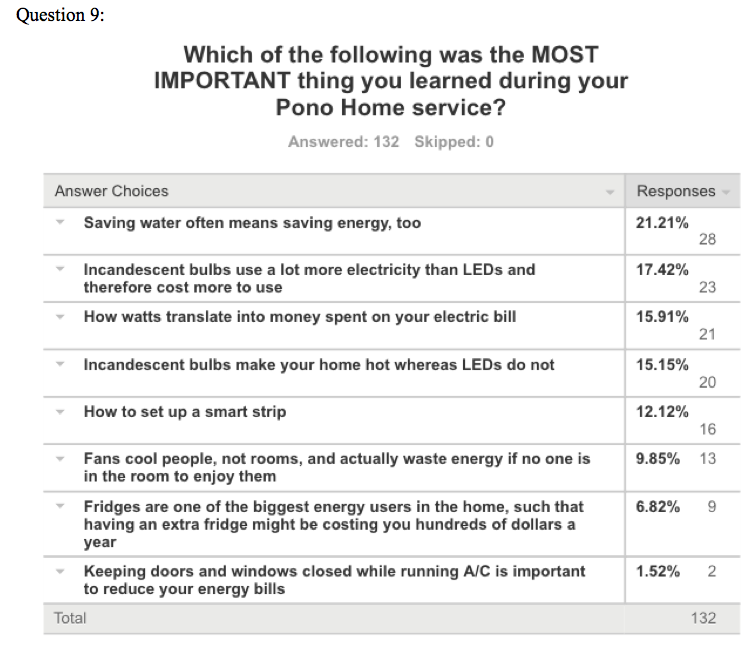
So how does water use affect energy use? There are several answers to this. The more intuitive is that water that comes out of your tap and shower is often heated. To heat water, energy is needed. This can be done by many means, but the most common (in order of least efficient to most) are electric resistance water heaters, gas water heaters, hybrid/heat pump, and solar. You pay for the electricity to heat that water, and the more hot water that’s used, the more the electric or gas bill will go up. So changing from a 2.5 gallon per minute showerhead to a 1.5 gallon per minute showerhead will save 1 gallon per minute of shower. For an 8 minute shower, that’s 8 gallons of heated water saved, meaning 3 types of savings: water, heating of that water, and disposal of that water (often referred to as sewer charges on your water bill). Over the course of a year or even a month, this adds up quick. We’ll discuss other water efficiency measures in a future module.
There are less obvious ways that conserving water also results in conserving energy. For water to arrive at your tap, it often needs to be transported great distances. Sometimes this can be done just by gravity, but that’s not the norm, especially in flatter geographic areas. If you’ve ever carried a heavy jug of water, you understand that it takes work (energy) to move that water around. This principle is one of the facets of a larger equation known as the “Water-Energy Nexus”. Every gallon that comes to your house had to be worked on (moved) there, and in many cases that means electricity usage in the form of pumping systems.
We will cover many ways to save water throughout these modules, including leak detection/correction, habits/practices, and devices that can be installed to save water (and therefore energy).
Suggested readings:
Clean technologies for water conservation and efficiency
Conservation: The Human Side
While there are some great technologies for conserving energy and water (see Further Readings, below), running an efficiency business without taking into consideration the human effect would short-circuit much of the gains available through technology. Many studies have shown that when utility customers understand energy better and how other people are doing, the overall amount of energy used is reduced. On this latter part, there are a number of companies educating customers this way, including OPower and WaterSmart. They both operate similarly–consumers of energy and water are sent literature that simply shows them how much they’re using compared to their neighbors and peers. Here’s an example of an OPower letter, with the customer’s information blocked out:
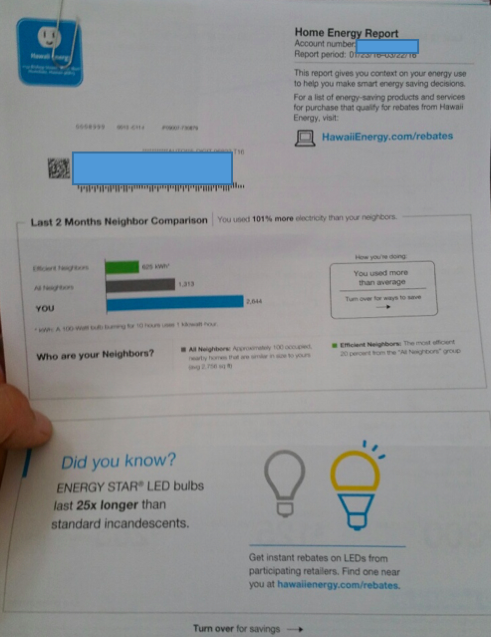
Note that “YOU”, in bold letters (blue bar), showcases that someone is using more energy than their neighbors (black bar), and way more than their “efficient neighbors” (in green). Peer pressure works, and both OPower and WaterSmart have been able to show effective reductions of consumption.
Now, people can do many things in their home to reduce their energy and water use (and thus greenhouse gas emissions). The trick is that they can have the opinion that it’s good to do, they can have the know-how and the tools, they can be given products so as to eliminate the financial barrier, and even with all that, studies have consistently shown that people will not do these things for themselves. While that is frustrating, it does create an economic opportunity for people like you to make a living helping people make their homes and small businesses more eco-friendly. Our whole economy is built on convenience, after all, so why would we expect sustainability to be any different?
Suggested readings:
Environmental attitudes vs. behavior: why the disconnect?
Marketing efficiency
Besides peer pressure, what works to help convince people to green their homes? The answer is not simple, since people are very different. The Natural Marketing Institute (NMI) was one of the original research firms, often credited with first developing segmentations of consumer groups broken down by how “green” they are. This graph represents how they believe people broke out by category.
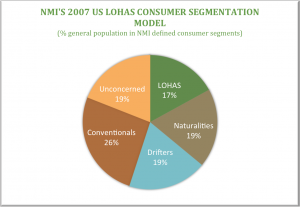
Some people are definitely motivated by environmental impacts. The NMI believes that the group with the greatest willingness to “vote with their dollars” is roughly 17% of the market. This demographic is called LOHAS, or Lifestyle Of Health And Sustainability. LOHAS consumers might tend to ride bikes to work or buy electric vehicles, as well as solar panels, and organic, locally grown food. When those people also don’t know how to make positive changes, they are often willing to just “pay someone else to do it” (e.g., buying carbon credits). These folks are less concerned about the financial side (cost and payback), so that aspect is little more than a reinforcement of their positive behavior. LOHAS consumers also tend to be the most educated and also tend to be high earners. Naturalites tend to be those people who generally want to live sustainably, but health and cost are heavily weighted as important aspects in their buying behaviors (even though impact is still important). So they’ll spend more money on organic, locally grown food, but might not buy carbon offsets. Marketing to these people will tend to be most effective when health is strongly emphasized. Drifters, the third demographic group, largely follow trends. Right now, sustainability and health are very trendy, which means that drifters can be marketed to with health and environmental messages, but financials will be probably the strongest pitch. Conventionals are people who are not usually exposed to health and sustainability messaging, and therefore, while not opposed to these messages, are not going to respond to them as readily. Many of this demographic have been told for years that “everything causes cancer, so why bother” and that perhaps even “global warming is a hoax”. Financial measures become far and away the biggest driving force for these folks, unless they’ve heard from a news source they deem trustworthy that BPA in their child’s bottle is harmful or that organic food is truly worth the additional money. The last group, which NMI dubbed the “Unconcerned” group, is the hardest to reach. We all know some of these people, and they tend to be jaded and unhappy, but satisfied with their position in life enough not to be motivated to do anything to make things better. Good luck getting through marketing to them on any level. 🙂
The way messages are presented and the words chosen are also very important. The term “low flow” (toilets, showers, etc.) has a bad rap, and for good reason. The early technologies offered to reduce water consumption simply blocked water going through a fixture like a shower head that was designed for higher flow rates, resulting in low water pressures and unhappy customers. New technologies are designed to aerate and pressurize the flow, resulting in a better user experience. In other words, a high efficiency showerhead is designed to make the most of 1.5 gallons per minute, rather than being designed for 2.5 and only receiving 1.5 after a flow restrictor reduces the rate. THUS, ALWAYS REFER TO YOUR WATER SAVING DEVICES AS “HIGH EFFICIENCY’, NOT “LOW FLOW”. It’s not only good marketing that will help people adopt these technologies, it’s also accurate. Compact fluorescent lightbulbs (CFL) are energy saving lights, but let’s be honest–people do not like them. Even “green” people use CFLs only because they save money and energy, not because they really believe them to be a superior product. The bottom line is that the products you install need to be great. Otherwise, people will feel like they’re making a sacrifice and eventually get tired of sacrificing or feeling like they are sacrificing while the rest of the world is living better. The survey conducted by Pono Home found that allowing people to “test drive” products before buying them/leaving them in place led to much higher satisfaction than other conservation programs, where residents are generally not given a choice. One amazing finding was that 99% of people were satisfied with their high efficiency showerhead, which is in marked contrast to many previous conservation programs with “low flow” showerhead installations. The survey also found that LED lights received incredibly high satisfaction ratings, mainly because Pono Home focused on great lights, with the right size, the right color spectrum, and the right brightness. The results show that when people do not feel like they’re sacrificing but rather feel like they’re “upgrading”, they’re stoked on the changes, and even if they’re not “green” people, they like feeling like they’re doing something good for the world.
Suggested readings:
Environmental attitudes vs. behavior: why the disconnect?
The Bottom Line (the financials)
Efficiency is hands-down the best financial investment we can make to reducing our impacts. Here’s a chart from the Institute for Local Self-Reliance that describes the cost per kilowatt hour of various energy sources:

How does this translate to the average home? Let’s use a simple example. A 60 watt lightbulb is replaced by an equivalent (brightness, color, shape) LED bulb that uses only 9 watts. This is referred to as a 60 watt equivalent, or 60wEq for short. An equivalent incandescent would produce the same amount of light but use 60 watts, with more than 90% of the electricity going to waste as heat. The savings are 51 watts. The average lightbulb in American homes is on about 3 hours per day, according to a report from the Department of Energy. That yields 3 hours x 51 watts = 153 watt-hours. Divide by 1000, and you have 0.153 kilowatt-hours (kWh). The average American cost per kWh is about 13 cents, which means that that LED bulb just saved 2 cents (1.989 cents, to be exact). For one year (multiply by 365 days), and you have $7.26 in savings. Multiply that by 50 or 60 bulbs in a home, and pretty soon, you’re talking real money.
Electric bills are generally read in kilowatt hours. Sometimes it is broken down by the time of use, so that during peak demand time, energy costs more. Sometimes there’s a progressive rate, as we mentioned above. Water bills are generally the same idea: measured in thousand gallon increments normally, and each have miscellaneous fees that cover infrastructure maintenance. Water bills also have a secondary charge for moving that water out of your home–a sewage charge.
What about solar? Solar photovoltaic systems (solar PV) generate electricity directly from sunlight. If a home solar PV system is producing more energy than the home is using, the homeowner can sometimes get credit toward future energy use, or even cash back. See “How Net Metering works” below, for more on that. Solar PV creates power in direct current (DC), and requires the use of an inverter to turn that DC into alternating current (AC) that is what we use in our homes.
Solar water heating is a bit different than solar PV – more on that below in the How Thing Work section.
Suggested readings:
True cost of LED vs. CFL vs. incandescent bulbs: payback period and life cycle savings
How to read and interpret an average electric bill
How To: Read a common water bill
Utilities in the Home, Key Takeaways
- Electricity in the home has many uses, and the choice of appliances, the use patterns, and several other factors will influence the cost of an electric bill.
- The top few appliances may account for a lion’s share of a home’s total energy use, so if people are going to focus their efficiency and conservation efforts somewhere, might as well hit the big users.
- It’s not obvious, but there’s a strong connection between energy and water. Using water often means using energy to heat and move that water, and those costs are passed on to the consumer through electric and water bills.
- Most people are supportive or at least not resistant to greening their home and habits, but it’s important to approach it with the right language and motivating factors. Knowing the type of demographic you’re talking to is very helpful in understanding motivations and effectively communicating the inherent value.
- Efficiency is the quickest and most cost-effective way to reduce electric and water bills and improve our environmental impacts.
How Things Work
Natural Gas vs. Electric Appliances
Many sustainability-minded homeowners have agonized over gas vs. electric much like shoppers sometimes agonize about paper vs. plastic. Overall efficiency will vary from place to place. At times, natural gas is more efficient than using electricity for the same end (e.g., drying clothes or heating water). In addition, natural gas can be a renewable resource, if it’s harvested from landfill or wastewater treatment plant off-gassing (often referred to as “methane capture technologies”). However, most natural gas is a fossil fuel, and these days, it is most prevalent as a result of “fracking” (hydraulic fracturing), which is exceptionally inefficient and toxic due to the chemicals used to dissolve rock and lubricate drilling equipment. Fracking has caused groundwater contamination across the country while also causing earthquakes and structural damage to buildings. In addition, gas well leaks are relatively common, and one gas leak in 2015 was described as the biggest leak in U.S. history. It not only caused health problems for residents (the long term consequences of which are still unknown), it released an equivalent amount of greenhouse gases in just over 100 days as two full coal-fired power plants will do in a year.
In addition, natural gas appliances have several major challenges in terms of safety.
- “Flame rollout” is the phenomenon in which the flame used in the appliance has seeped beyond the normal combustion area. This is exceptionally dangerous, and if noted, you should notify the customer immediately.
- Leaks. Many times, simply jostling the connections to a gas clothes dryer can cause gas to start leaking. As natural gas is about 20x more potent as a greenhouse gas than carbon dioxide, this is not only a waste of money but a big environmental issue. If you smell something like rotten eggs, you may be smelling a gas leak. Natural gas is odorless, but the utilities add a chemical to the supply line that has a strong odor so that residents can detect leaks. If you detect a leak, contact the local utility/gas provider immediately. They will usually send a tech.
- Backdrafting. Normally, gases are vented through a flue or other exhaust pipe. There is negative pressure designed into the system so that gases naturally will head toward that negative pressure area (flowing from high pressure to more voided out areas), and when heated, these gases usually flow upward as well, which is why natural gas venting is set up as it is. However, at times, the pressure inside the house is lower than that outside the house, causing the gases (and the flame) to backdraft into the living space. This is of concern for Pono Home due to the idea that while we want to seal air leaks in the home, when we do, if there is consistent withdrawal of gases through a flue, the overall air pressure in the home will drop (no new gases can come in from elsewhere), and eventually, the pressure inside the home will suck the escaping gases back. If this happens, the exhaust products (carbon monoxide, of particular concern) can sicken or even kill people inside the home. A little bit of backdrafting is not likely to hurt anyone, but if you see signs of it, you should let the customer know. Here’s some images of evidence of backdrafting of combustion appliances and exhaust.
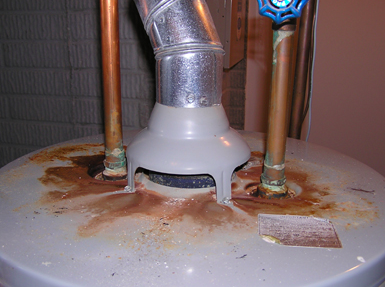
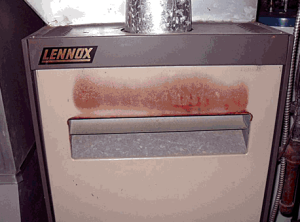
So while the direct efficiency of a gas appliance may be better than many electric equivalents, the bottom line is that there’s a lot more to consider. If the home can be solar powered with electric appliances, that’s far better. If the natural gas in that area is from a renewable resource (methane capture), that might be better. In any and all cases, however, efficient use of those appliances (e.g., whether it’s a gas or electric water heater, using less hot water is still the best, most effective step in the sustainability journey).
Suggested additional materials:
- Gasland, official documentary trailer. This documentary is an eye-opening look at the truly insane world of fracking.
Refrigerator and Freezer
The fridge and freezer can account for 6-10% of a monthly residential electric bill. Contents are cooled by using electricity to turn a refrigerant chemical from a liquid to a gas, and then condensing that gas back into a liquid. As it condenses, it absorbs heat, thus cooling the fridge’s interior:
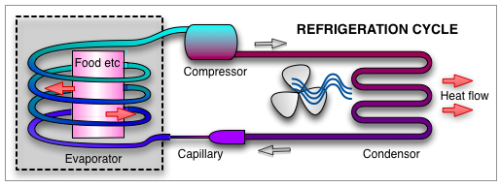
To keep the system running efficiently, regularly clean the condenser coils, set temperatures in efficient range, and keep both fridge and freezer at least 2/3rds full.
Further reading:
HVAC
HVAC stands for Heating Ventilation and Air Conditioning, and the systems are combined in your home through a series of ducts and vents. For heating, cool, outside air is drawn into a boiler where it is heated, and then distributed through the house’s vents.
For cooling, fresh air is drawn into the home, circulated through the A/C compressor for cooling, distributed through the house’s ducts, then drawn out through vents blowing out of the house. This provides a steady stream of fresh air through the home. Heat exchangers, though not in most houses, allow the system to recapture some of the heating or cooling in the old air before it is expelled, by transferring that temperature to the new air coming in (without directly mixing with the new air, so as to maintain indoor air quality).
Evaporative coolers work well in some climates, and whole house fans work great wherever night time temps drop enough for the home to be cooled quickly at night. They also provide excellent ventilation and improve indoor air quality.
Important to understand for energy efficiency with regard to HVAC systems is insulation and R value. R is a measure of resistance to energy flow, in this case, from hot to cold. The higher the R value, the more resistance to the flow of energy from temperature differences. Thus, insulation is rated with R values, with the higher R value insulation meaning you lose less energy. In northern climates, it’s common for building codes to require R values of attic insulation in the 50 range, whereas in tropical climates, it’s less.
Further reading:
Clean technologies for heating and cooling
Insulation and air sealing considerations
Water Heaters
Gas and electric water heaters work in similar ways, but have some fundamental differences. Cold water comes into the tank, and since it’s denser than hot water, it settles to the bottom, where a burner/heater heats it up. Pretty straightforward, but water heaters, since they’re full of hot water all the time, tend to corrode from the inside out. If left to their own devices, the hot water would literally eat the inside walls away. Enter the anode rod. This rod is placed into the middle of the water heater and gives the ions in the hot water an “easier target” than the lining of the walls. Think of it this way–if you had the choice between a plain baked potato and one roasted with olive oil and salt and pepper, you’d more than likely choose the tastier option. The anode rod is simply the preferred place for the ions in the hot water to bind. Thus, the anode rod protects the lining of the tank. It also means that the anode rod will eventually get dissolved, and when that happens, the hot water will then begin to attack other parts of the water heater and cause it to fail. It’s important to replace the anode rod every so often (6-12 years, depending on the quality).
Here’s a diagram of a water heater, to help elucidate how they work:
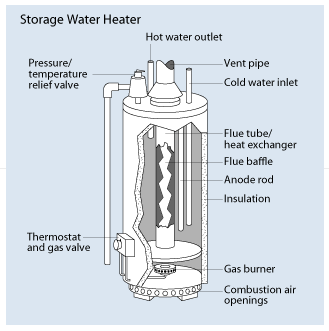
Insulation is very important to water heaters, since they work hard to heat water and keep it ready for use. Both the tank and the pipes need insulation. Most modern water heaters come with insulation already in place, and unless they are warm to the touch, there’s likely little need for more insulation (a laser thermometer will give a more accurate reading, and if the tank is warmer than the ambient temp in the room, then insulation around the tank may indeed help reduce energy bills). Pipes, however, are very infrequently insulated. We’ll cover this in more detail in a later module.
Solar water heaters are very neat clean tech innovations.
There are active and passive solar water heaters. Active ones have circulating pumps and controls. Passive ones do not. Among active solar water heating systems, there are two types. One is direct, where water is simply circulated up to the roof and heated by sunlight directly in a solar collector. These work well in tropical climates.
For places where temperatures get down to freezing, however, an indirect (or “closed loop”) circulation system is the active solar hot water heater you’ll most commonly find. These are closed-loop systems in which an antifreeze fluid is circulated up to the roof, heated, and then circulated down to a heat exchanger, where its heat is transferred to the water tank, thus heating the water indirectly. The cooler antifreeze is then recirculated back up to the roof and heated again. For the purposes of this article, we address direct circulation pumps, but the mechanics are not that different from that to indirect ones.
A quick guide to how a solar hot water heater works
Most solar water heaters use direct heat. In other words, there are pipes that run from the water heater up to the roof, and during the day, they collect heat from the sun, which heats the water inside the pipes, which is then circulated through the system and fills the tank.
Additional reading:
How a conventional hot water heater works (gas or electric) (and tips for maximum efficiency)
Hot Tub and Pool Pumps and Filters
Depending on your pump settings and pool size, a residential pool could be using up to 1300 kWh of electricity a month, much of it unnecessary! Pool pumps and filters work together inside of a closed system. The pump circulates the water, while the filter removes debris. If either the filter for the pool becomes clogged with debris from the pool, it will cause the pump to work harder, and the system as a whole will draw more power and cost more money to operate. Keeping drains clean and clear, installing a pool cover and reducing your pool’s pump time are great ways to make your system more energy efficient.
Heat pumps work by simply taking heat from the outside air and transferring it to the water. Check out the video below to get a better understanding of how your pool’s heat pump works:
Further readings:
How Your Pool Pump and Filter Work